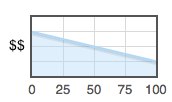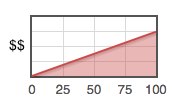If you’re an owner-operator or a small trucking fleet manager or owner, it’s a must that you understand the costs of operating your business. It’s not an extra bonus that’ll get you a little extra money; it’s what separates the wheat from the chaff in this business. The guys who never get around to studying and analyzing their costs are the ones who either don’t make it very long, or who don’t make much money.
So this article will be a quick introduction to some basic ways to think about your trucking costs. If you’re new to thinking about your costs, this should help you get a grasp of what to be thinking about, at least for the big picture.
So, to start with: there are two main categories that all your costs are in:
Fixed costs are the expenses you have whether you’re driving your truck or not. Examples of fixed costs include:
Truck mortgage payments and insurance payments are usually the biggest fixed costs.
Variable costs are the expenses you pay when you drive your truck. The amount you spend increases directly along with the amount of miles you drive. Examples of variable costs include:
Driver pay can fit into either fixed or variable, depending on how it’s calculated. A flat salary would be a fixed cost, and a per mile pay structure would be variable.
Fuel and driver pay are the highest variable costs, depending on the cost of fuel.
Below, you can see a couple graphs that visually show you the difference between fixed and variable costs. One stays the same, no matter how many miles you’ve driven; the other goes up. Pretty simple.

Total Fixed Cost vs Miles Driven (thousands)

Total Variable Cost vs Miles Driven (thousands)
Okay, so there are fixed costs and variable costs. What’s the big deal about that? Why is that important?
It’s important because it lets you understand what’s important to your business.
First, once you add up all your fixed costs (and do so in a careful, complete way), it will let you know, at its core, the daily expense of running your business. Doing this helps you in several ways:
Keeping track of your variable costs helps in similar ways:
And comparing your fixed and variable costs gives you insight into your business. You understand it all better and know what the important areas are to focus on. You’ll know what jobs are profitable. You’ll know that you can wait for a bigger job a few days away because your per-day fixed costs are maybe not as big as you’d imagined. You can figure out how much a deadhead will cost and make a smart, informed decision and not just be flying (driving?) by the seat of your pants.
There isn’t a lot you can do to reduce your fixed costs, but it is possible. You can:
Another way to reduce your fixed costs is to run more miles. Well, this doesn’t technically reduce your fixed costs, but as the number of miles goes up, it does reduce your per-mile expenses. Your fixed costs stay the same, so the cost-per-mile decreases. You can see this illustrated in the graph below.

Total Variable Cost vs Miles Driven (thousands)
There are lots of things you can do to reduce variable costs. This is where attempting to cut costs really pays off big, as there are so many things you can do.
Examples of areas where you can focus your efforts:
There is basically no end to improvements you can make on the variable costs side. And, you probably already know trucking is a small-margin business–meaning that even tiny improvements you can make to variable costs will boost your income big-time.
Okay, that’s it for our introduction to fixed and variable costs.
If you want to go more in-depth on these kinds of costs, check out this article ‘Understanding owner-operator expenses and costs.’
My name is Jason Forrest, and I’m the creator of Rigbooks. Rigbooks is a cloud-based software that makes it easier for small and medium-sized trucking companies run their business while keeping organized. We’ve been around since 2010.
A little about me: I grew up in a trucking family and from an early age I learned about the day-to-day problems that truck owner/operators have to deal with. I was into computers and programming as a kid so over the years I helped write small computer programs that helped my parents run their company better. Eventually that led to the idea of putting all those tools together in one package. And Rigbooks was born.